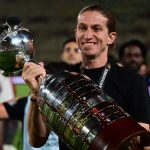Bonarda, the second red variety planted in Argentina after Malbec and for a long time used as a base for common red wines due to its high yields and its color contribution, it currently celebrates its ability to improve blended wines and as a varietal in quality wines.
From August 1 to 7, for the second consecutive year, Bonarda Week will be held, an initiative of the Wine Fund that brings together wineries and different actors in the sector with the aim of promoting this variety with activities throughout the country.
According to the National Institute of Viticulture (INV), based on data from 2020, with 18,153 cultivated hectares (8.5% of the total grapevine in the country), the varietal is present in most of the wine-growing provinces of Argentina.
With some 15,162 hectares (83.5%), the province of Mendoza has the largest number of grapevines in the country; followed by San Juan, with 2,210 hectares (12.2%); and the rest of the provinces, with 781 hectares (4.3%).
In production, with 2,123,369 quintals, the Bonarda represented 10.3% of the total harvest in the 2020 vintage, only behind Malbec and the Cherry variety (belonging to the so-called Creole varieties).
Between the 5,071,538 hectoliters of wine sold in 20204.9% corresponded to Bonarda (166,288 hl cut with some other variety and 79,782 hl of pure varietal wine), with significant increases in sales in recent years.
Arriving in the country with the immigration currents at the end of the 19th century and beginning its cultivation in the Cuyo region, this variety was used for a long time as a base for common red wines due to its high yields per hectare and its important color contribution; and to improve blended wines, especially with Malbec.
“In the past this varietal was for mass consumption or was used for cuts; lately it has gained significant prestige and we must work hard to promote the presence of Bonarda bottles in restaurants”affirmed in this sense the mayor of the department of Mendoza, Gral. San Martín, Raúl Rufeil.
Given the discovery of its oenological potential, the production per hectare was reduced, achieving an improvement in quality, which is why it began its development as a varietal from which high-quality wines are made, explained the INV in its latest report on the strain.
In this sense, the winemaker of Cotton Wines Mauro Nosenzo assured Télam that “it is a variety with great oenological potential in Argentina and, although it will never replace Malbec, it is important for blends, very noble and manageable, the one that best suits to make blends or blends for premium wines, and even as a varietal”.
For his part, the oenologist Jorge Rubio, from the homonymous winery, considered that “Growers like it because it is a very vigorous variety that yields many kilos per hectare; although, when you reduce the yield of the plant, you get very good quality.”
“The Bonarda in Argentina has always been used for cutting, because it gave good yields, especially in the east, in San Martín and Santa Rosa; today we have achieved an ultra-premium Bonarda in Agrelo, in a different terroir, with a different height, another microclimate. and also other farm management, with much lower yields but higher quality,” said Soledad Buenanueva, Dante Robino’s oenologist.
This Italian red wine grape, ancestor of the French variety “Corbeau de Savoie”, is today more abundant in Argentina; and in 2011 the INV accepted the name Bonarda Argentina to refer to this variety grown in the country.
Thus, Nosenzo considered “it is important to have it on display because it is an Argentine variety with excellent results.”
“It is a variety that does not exist in Europe and that gives us an advantage, it is a wine that is made only in our country, which is important in global markets,” Rubio explained to Télam.
“It was possible to produce a high-quality Bonarda and today we don’t want that to stop here, but to go further and further,” Buenanueva added, in statements to Télam.
They indicated that there is an increase in exports of Bonarda wine (pure and with cuts), and they cite that in 2020 the largest volume of the entire decade was exported, reaching a total of 56,000 hl, for an FOB value of US$ 8 .97 million.
The main destination for pure varietal wines in 2020 was Canada, followed by Russia.
Then come Brazil, France and the United States; and for the Bonarda with cuts, the main recipients were: Ireland, United Kingdom, Czech Republic, Paraguay and Belgium.
















